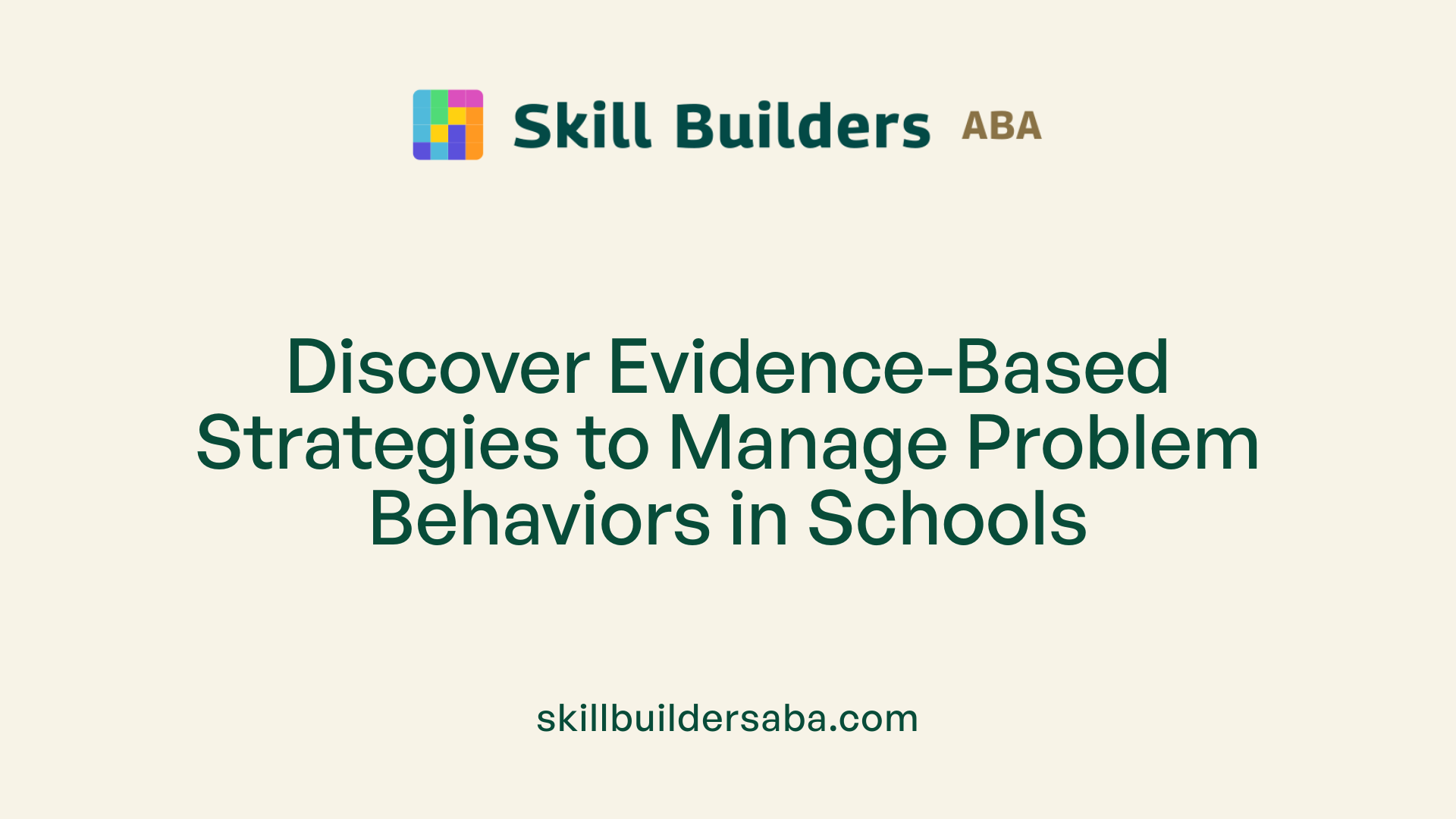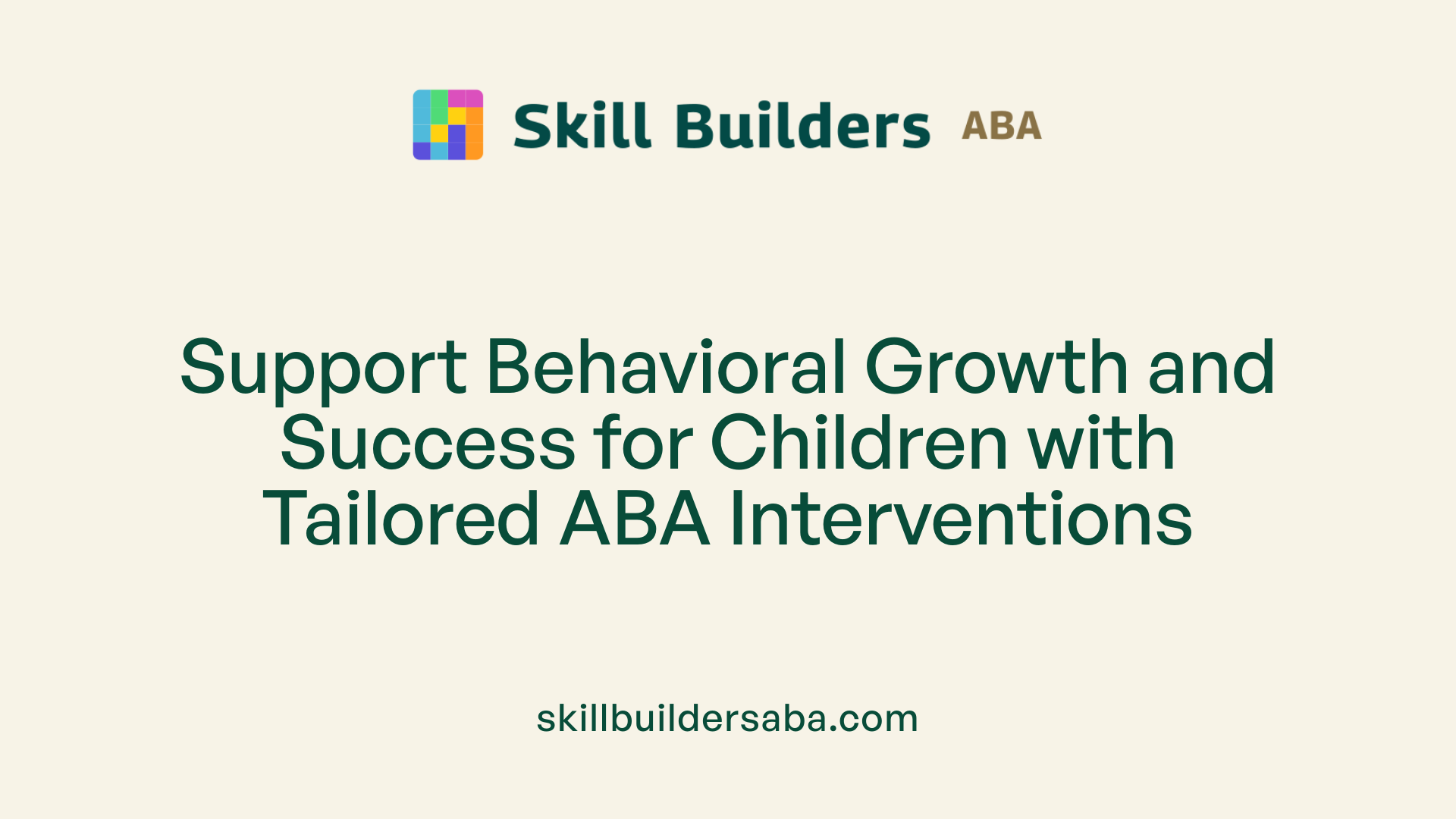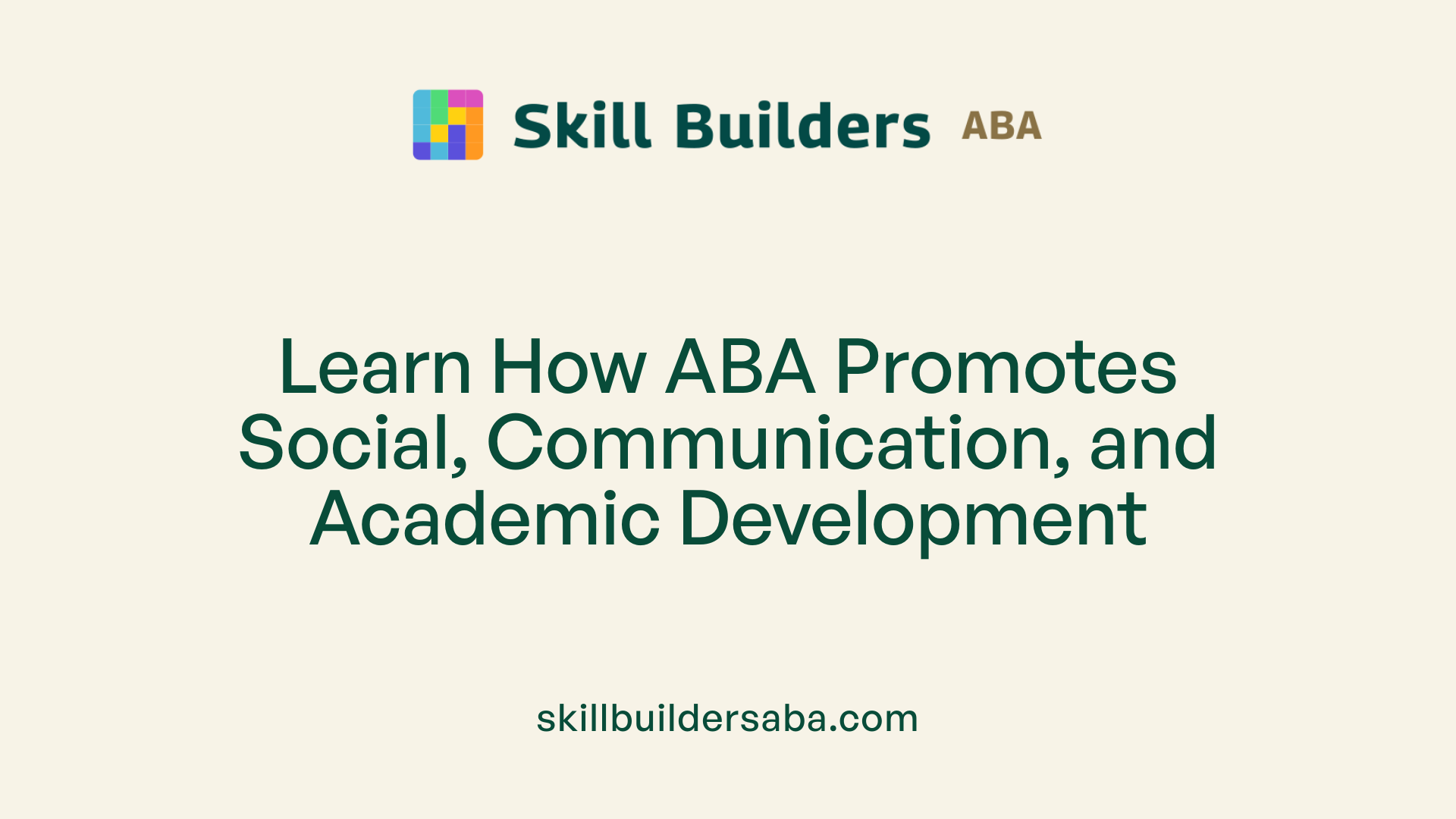
How does ABA therapy address problem behaviors in school settings
Behavioral Support Strategies for a Positive Classroom Climate
Understanding the Role of ABA in Educational Settings
Applied Behavior Analysis (ABA) is a scientifically validated approach that has proven effective in managing and improving problem behaviors among students with autism spectrum disorder (ASD) and other behavioral challenges in school environments. By systematically understanding the functions of behaviors through assessments such as functional behavior assessments (FBAs), ABA helps educators and specialists develop personalized interventions aimed at promoting positive, adaptive behaviors. This article explores how ABA addresses problem behaviors, the strategies it employs, and the broader benefits for students' social, behavioral, and academic development.
Foundations of ABA in Schools
How does ABA therapy address problem behaviors in educational environments?
ABA therapy plays a vital role in managing challenging behaviors within school settings. It accomplishes this through a systematic process of understanding the underlying reasons behind behaviors via functional behavior assessments (FBAs). These assessments analyze antecedents—what happens before a behavior—along with the behavior itself and its consequences.
Based on this analysis, qualified professionals like Board Certified Behavior Analysts (BCBAs) develop personalized intervention strategies called Behavior Intervention Plans (BIPs). These plans focus on teaching replacement skills such as effective communication, social skills, or self-regulation techniques that serve the same purpose as problematic behaviors.
Interventions are tailored to each child's specific needs and environmental context. The use of positive reinforcement encourages desired behaviors, making it more likely for children to repeat those behaviors in the future. For instance, praise or tokens can reward a student for asking questions appropriately instead of exhibiting disruptive behavior.
Consistent data collection and progress monitoring are essential components. They help educators and therapists evaluate the effectiveness of interventions, making adjustments as necessary. This ongoing process ensures that strategies are successfully reducing harmful behaviors toward promoting adaptive, functional behaviors.
In summary, ABA creates a supportive framework that not only minimizes problematic behaviors but also fosters skill development, thereby enhancing a child's ability to succeed academically and socially in school environments.
Behavioral Techniques and Interventions

What strategies does ABA therapy use to manage problem behaviors in school settings?
ABA therapy applies a range of effective, evidence-based methods to address challenging behaviors within schools. Central to this approach are positive reinforcement techniques, such as token economies, which reward students for exhibiting desirable behaviors like completing tasks or following instructions. These reinforcement systems help motivate students and encourage behavioral improvements.
Structured teaching methods, such as Discrete Trial Training (DTT), break down complex skills into small, manageable steps. These units are taught with repeated practice and immediate reinforcement, making skill acquisition clear and measurable.
Naturalistic teaching strategies, including Pivotal Response Treatment (PRT), promote learning through everyday routines and naturally occurring activities. This method enhances communication, social skills, and the generalization of learned behaviors across settings.
To effectively manage behaviors, therapists develop individualized behavior intervention plans based on functional behavior assessments (FBAs). These plans identify the triggers and consequences that maintain problem behaviors, enabling tailored interventions that reduce disruptive actions.
Consistency and data collection are vital. Ongoing monitoring helps determine whether strategies work, and adjustments are made as needed. Environmental modifications—such as visual supports and structured schedules—further support positive behavior.
Together, these strategies foster a supportive learning environment where students can develop essential skills, improve their behavior, and succeed academically and socially.
Supporting Children with Behavioral Challenges

How can ABA therapy support children with behavioral challenges in school?
ABA (Applied Behavior Analysis) therapy provides tailored, evidence-based strategies to help children facing behavioral challenges in educational settings. Trained professionals, including licensed behavior analysts like BCBAs and Registered Behavior Technicians (RBTs), develop and oversee individualized programs that address each child's specific needs.
In schools, ABA techniques such as positive reinforcement, Discrete Trial Training (DTT), and naturalistic teaching methods are used to foster skills like effective communication, social interaction, and self-regulation. These strategies not only reduce problematic behaviors but also promote active engagement with learning tasks.
ABA interventions facilitate skill development in various areas, including peer relationships and independence in daily activities. For example, using token economies or praise systems can motivate students to participate more fully and improve their classroom behavior.
Collaboration is essential for success. When teachers, parents, and school staff work together, they ensure consistency in applying strategies across different environments, which supports the generalization of skills. Regular data collection and progress monitoring allow for adjustments to interventions, making sure they remain effective.
Overall, school-based ABA therapy aims to create a positive learning environment where children with behavioral challenges can thrive academically, socially, and emotionally. By addressing individual needs through a team approach, ABA helps children develop the skills necessary for success in and out of the classroom.
Enhancing Social and Academic Skills

How does ABA therapy help students develop social and academic skills?
ABA therapy significantly boosts students' abilities to communicate, interact socially, and excel academically. It uses carefully structured instructional techniques like Discrete Trial Training (DTT), Natural Environment Teaching (NET), and Pivotal Response Treatment (PRT). These methods break down complex skills into manageable steps, making learning more accessible.
A central element of ABA is positive reinforcement, which encourages students to repeat desired behaviors. Reinforcement systems such as token economies motivate students to participate actively—whether it's cleaning up, raising a hand, or sitting appropriately at their desks.
Assessment plays a crucial role. Functional Behavior Assessments identify the specific reasons behind a student's challenging behaviors, guiding the creation of tailored behavior intervention plans (BIPs). These plans include strategies like teaching alternative behaviors, using preventive measures, and consistently collecting data to track progress.
Collaboration among teachers, behavior analysts, therapists, and families ensures consistency across environments. This team effort helps in effectively generalizing skills learned in therapy to various settings, including classrooms and community environments.
Through this integrated approach, ABA not only improves communication and social skills but also enhances academic performance. Students become more independent, better equipped to participate fully in school activities, and demonstrate positive behavioral changes that support lifelong success.
Generalization and Inclusive Practices

How does ABA therapy address problem behaviors in educational environments?
ABA therapy tackles problem behaviors in schools through a deep understanding of what causes these behaviors. Qualified professionals, such as Board Certified Behavior Analysts (BCBAs), perform functional behavior assessments (FBAs) to identify the triggers and functions of challenging behaviors.
Once the root causes are known, ABA develops personalized strategies that include teaching appropriate replacement skills. For example, if a child displays aggression when seeking attention, therapy might focus on teaching the child more acceptable ways to get attention, like raising a hand.
Positive reinforcement plays a crucial role in encouraging desired behaviors. Reinforcements such as tokens or praise motivate children to adopt socially appropriate actions. These strategies are tailored to the individual, considering their specific needs and classroom environment.
Data collection is continuous, helping therapists and teachers monitor progress. Adjustments are made based on ongoing assessment to ensure that interventions remain effective.
Overall, ABA creates a structured, supportive approach that reduces harmful behaviors while promoting skills essential for successful functioning in educational settings. It makes learning more accessible and fosters positive social interactions.
Promoting skill generalization across environments
One of the fundamental principles of ABA is ensuring that skills learned in one setting are transferable to others. This is called generalization.
In schools, therapists introduce skills in varied situations, including different classrooms, during recess, and in activities with peers. Using natural environment teaching (NET), they leverage real-life situations for learning, which supports spontaneous and functional use of new skills.
Visual supports such as schedules, cues, and social stories assist children in understanding expectations across environments, reducing anxiety and confusion.
Supporting inclusion with visual supports and accommodations
Visual supports are vital in promoting inclusive environments. These tools help students with diverse needs to understand routines, rules, and activities, making classrooms more predictable.
Accommodations like sensory-friendly seating, quiet spaces, or visual timers can help children manage sensory sensitivities and attention challenges.
In addition, visual supports facilitate communication for non-verbal or minimally verbal students, enabling greater independence.
Peer-mediated interventions and fostering an inclusive culture
Including peers in intervention strategies can promote social skills and acceptance. Peer-mediated interventions involve training classmates to interact positively and support students with autism.
Creating an inclusive culture involves fostering understanding and acceptance among all students. This can be achieved through classroom discussions, inclusive activities, and promoting peer awareness.
Such initiatives not only support social integration but also help develop empathy and collaborative skills among students.
| Strategy | Purpose | Implementation Example | Effectiveness |
|---|---|---|---|
| Visual Supports | Enhance understanding and predictability | Schedules, social stories, cue cards | Increase engagement, reduce anxiety |
| Natural Environment Teaching (NET) | Promote spontaneous use of skills | Teaching during recess or group activities | Supports real-world application of skills |
| Peer-Mediated Interventions | Increase social interaction and acceptance | Peer training programs to support communication | Improves social skills and peer relationships |
Maintaining collaboration among educators, therapists, and families is essential. Ongoing professional development and consistent practices foster an inclusive and supportive learning environment. Individualized plans, integrated visual supports, and peer involvement all work together to ensure children with autism succeed academically and socially.
Implementing ABA in School Settings

How does ABA therapy address problem behaviors in educational environments?
ABA therapy plays a crucial role in managing and reducing problematic behaviors among students with autism in school settings. It begins with a thorough functional behavior assessment (FBA) to identify the underlying causes and triggers of challenging behaviors. By understanding the purpose or function of these behaviors—such as seeking attention, avoiding tasks, or escaping social situations—educators and therapists can develop targeted interventions.
One of the fundamental strategies in ABA is positive reinforcement, which encourages desired behaviors by providing rewards or incentives. For example, a student might receive a token or praise for using words to ask for help instead of acting out. These interventions are highly individualized, designed by licensed behavior analysts (BCBAs) to suit each student's unique needs and environment.
Data collection is continuous, allowing teams to monitor progress and adjust strategies promptly. This systematic approach not only helps in reducing harmful behaviors but also promotes the development of alternative, more acceptable behaviors that serve the same function.
In practice, ABA addresses problem behaviors by teaching replacement skills such as communication, social interaction, and self-regulation. This process helps students participate more fully in classroom activities and develop adaptive behaviors essential for success.
Training and professional development for staff
Effective implementation of ABA requires proper training for teachers and school staff. Professional development programs focus on teaching ABA principles, data collection techniques, and behavioral management strategies. When staff are well-trained, they can more confidently implement behavioral interventions, leading to more consistent and successful outcomes.
Developing collaborative team approaches
Successful ABA integration relies on teamwork among educators, behavior analysts, therapists, and families. Regular communication, shared planning, and joint review of data ensure strategies are consistent across settings. Developing a collaborative approach fosters a positive environment where students receive cohesive support.
Involving parents and families
Parents are vital partners in ABA therapy. Their involvement ensures that positive behaviors and skills learned at school are reinforced at home. Schools often include families in planning and training sessions, promoting generalization and consistency in intervention strategies.
| Aspect | Focus | Details |
|---|---|---|
| Staff Training | Professional development | Teaching ABA strategies to teachers, aides, and staff |
| Team Approach | Collaboration | Coordinating efforts among school staff, behavior analysts, and families |
| Parental Involvement | Home support | Engaging families in planning and reinforcing skills |
Implementing ABA in schools involves a comprehensive, team-based approach centered on understanding behavior functions, delivering individualized interventions, and fostering collaboration. Proper training of staff and active parental participation further enhance the effectiveness of ABA strategies, creating a supportive environment where students can thrive academically and socially.
Supporting Success through Multi-Disciplinary Collaboration
How can ABA therapy support children with behavioral challenges in school?
ABA therapy can play a vital role in helping children facing behavioral challenges within educational settings. It offers tailored, evidence-based strategies that are designed to meet each child's unique needs. Licensed professionals, such as Board Certified Behavior Analysts (BCBAs) and Registered Behavior Therapists (RBTs), implement interventions like positive reinforcement and structured teaching methods to foster meaningful development.
In schools, ABA techniques such as Discrete Trial Training (DTT) break down complex skills into manageable steps, providing immediate feedback and reinforcement. Natural Environment Teaching (NET), on the other hand, promotes learning in real-life situations, helping students apply skills across different contexts. These strategies address communication, social skills, and self-regulation, ultimately reducing problematic behaviors.
Collaboration is essential to maximize ABA’s effectiveness in schools. Teachers, parents, and mental health professionals work together to create consistent intervention plans that reinforce skills both at school and home. This team approach ensures that children receive continuous support, making skill generalization possible and promoting better academic and social outcomes.
School-based ABA programs aim not only to modify behaviors but also to boost engagement, enhance peer interactions, and improve overall classroom participation. When integrated successfully, ABA helps create a supportive learning environment where children with autism or behavioral challenges can thrive academically, socially, and emotionally.
What is a multi-disciplinary approach?
A multi-disciplinary approach involves collaboration among various professionals—educators, behavior analysts, therapists, and families—to develop comprehensive strategies that support the child's growth.
This approach ensures interventions are personalized, addressing academic skills, behavioral challenges, and social development concurrently. Training and ongoing support for school staff help maintain consistency, while regular data collection monitors progress and guides necessary adjustments.
Ultimately, integrating ABA within a team framework fosters an inclusive atmosphere that promotes positive behavioral changes and supports each child's success, both inside and outside the classroom.
Fostering a Supportive Learning Environment
Implementing ABA therapy in schools is a strategic approach to create an inclusive and positive educational atmosphere. By focusing on individual needs and utilizing evidence-based techniques, schools can effectively reduce problem behaviors, enhance social and academic skills, and promote meaningful participation among students with diverse behavioral challenges. Collaboration among educators, behavior analysts, and families is essential to sustain these interventions and ensure lasting success. As schools continue to embrace ABA principles, they pave the way for a more supportive environment where all students can thrive academically, socially, and emotionally.
References
- How to Advocate for ABA Therapy Services in School Settings
- ABA Therapy in School - Brady Behavioral Analysis
- School-Based ABA Therapy - Surpass Behavioral Health
- Integrating ABA Therapy in Schools: Strategies for Success
- The Reality of In-School ABA Therapy
- Applied Behavior Analysis (ABA) | Autism Speaks
- ABA Therapy vs School: What's Best for Your Child?
Get Answers and Explore Your Options
Take a moment to browse our site to get a sense of our services and approach. If you’d prefer a direct conversation about next steps, you’re welcome to get in touch with a care coordinator.
Reach Out Today
Learn more about how we can support your child’s growth and development. Contact us to discuss our services and availability in your area.
.svg)